Keeping your guitar in top condition is crucial for any guitar player, and a vital part of that is knowing how to restring it properly. Fresh strings can dramatically improve your guitar’s sound, making it brighter and more resonant. This guide will walk you through each step of how to restring your guitar, ensuring optimal sound and playability. Let’s dive into the process of restringing your guitar to bring it back to its best.
Preparing Your Guitar for New Strings
Before you even think about putting on new strings, take advantage of this opportunity to give your guitar some much-needed attention. With the strings off, you can reach areas that are normally inaccessible.
Deep Cleaning Your Guitar
Now is the perfect time for a deep clean. Dust and grime can accumulate in hard-to-reach places like the fretboard, saddle, bridge, and scratchplate (if your guitar has one). Use a soft cloth to wipe down these areas, removing any buildup. A clean guitar not only looks better but can also contribute to better sound and longevity of the instrument.
 Close-up of a guitar body being cleaned, emphasizing the saddle and bridge areas
Close-up of a guitar body being cleaned, emphasizing the saddle and bridge areas
Conditioning the Fretboard
For guitars with dark wood fretboards like rosewood or ebony, applying lemon oil can help keep the wood hydrated and prevent cracking, especially in drier climates.
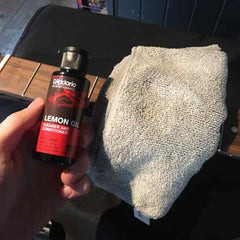 Applying lemon oil to a dark wood guitar fretboard with a soft cloth
Applying lemon oil to a dark wood guitar fretboard with a soft cloth
Apply a few drops of lemon oil to a clean cloth. Gently work the oil into the fretboard wood, moving along the grain of the wood from the nut to the guitar body. Allow the oil to soak in for about 30 seconds, but don’t let it dry completely.
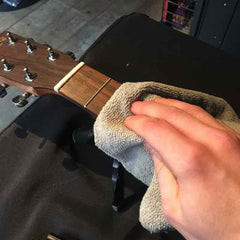 Close-up showing lemon oil being worked into the guitar fretboard with circular motions
Close-up showing lemon oil being worked into the guitar fretboard with circular motions
Hydrating the Bridge
Similar to the fretboard, the bridge can also benefit from hydration, especially if it appears dry. Be careful when applying lemon oil to the bridge; if your guitar has a saddle, remove it first, or avoid applying oil directly to it. Lemon oil on the saddle can cause strings to slip, affecting tuning stability.
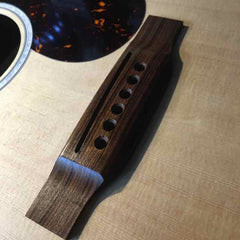 Lemon oil being carefully applied to a guitar bridge, avoiding the saddle area
Lemon oil being carefully applied to a guitar bridge, avoiding the saddle area
Restringing Your Guitar: Step-by-Step
Now that your guitar is clean and prepped, it’s time to put on the new strings. Follow these steps carefully to ensure your guitar is correctly restrung and ready to play.
Step 1: Prepare Your New Strings
Open your new set of guitar strings. Before you start, take a moment to identify the order of the strings. String packs are usually arranged from thickest to thinnest, corresponding to the low E to high E strings on your guitar. Understanding this order is key to stringing your guitar correctly.
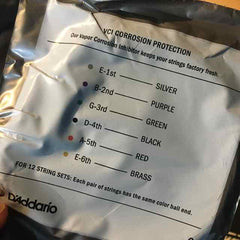 New pack of guitar strings, highlighting the string order and gauges
New pack of guitar strings, highlighting the string order and gauges
Step 2: Creating a Bend for Ball End Insertion
To ensure the ball end of the string sits securely against the bridge plate inside the guitar, create a slight 45-degree bend at the ball end of the string. This bend helps position the ball end correctly and improves tuning stability by ensuring consistent string seating.
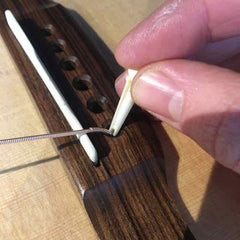 Close-up showing a 45-degree bend being made at the ball end of a guitar string
Close-up showing a 45-degree bend being made at the ball end of a guitar string
Step 3: Inserting the String and Bridge Pin
Insert the ball end of the string into the corresponding hole in the bridge. Place the bridge pin over the string, ensuring the string’s tail sits in the groove of the pin. The groove on the bridge pin should be facing towards the guitar neck to properly secure the string. Push the bridge pin firmly into place to secure the string.
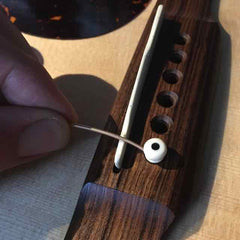 Inserting a guitar string ball end and securing it with a bridge pin, groove facing down
Inserting a guitar string ball end and securing it with a bridge pin, groove facing down
Step 4: Securing the Remaining Strings at the Bridge
Repeat steps 2 and 3 for the remaining five strings. After inserting all the strings and bridge pins, gently pull on the tail of each string to confirm that the ball end is firmly seated against the bridge plate inside the guitar body. This ensures proper string anchoring.
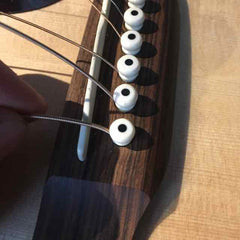 All six guitar strings inserted and secured with bridge pins at the bridge
All six guitar strings inserted and secured with bridge pins at the bridge
Step 5: Preparing the Tuning Pegs
Before threading the strings through the tuning pegs, make sure the holes in each machine head are aligned straight down the guitar neck. This starting position makes string insertion easier and sets up for optimal winding.
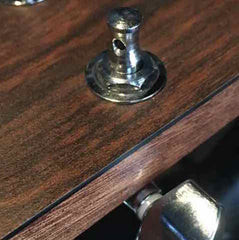 Guitar headstock with tuning pegs holes aligned straight down the neck
Guitar headstock with tuning pegs holes aligned straight down the neck
Step 6: Threading the String Through the Tuning Peg
Bring the string up from the bridge, over the saddle, across the nut, and thread it through the hole in the corresponding tuning peg. Ensure the string sits properly in the nut slot and saddle groove.
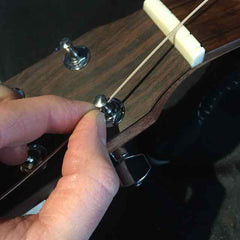 Threading a guitar string over the nut and into the tuning peg hole
Threading a guitar string over the nut and into the tuning peg hole
Step 7: Measuring and Cutting String Length
Pull the string taut and measure approximately two tuning pegs past the current tuning peg. This length will provide enough string to wrap around the tuning post several times, which is crucial for tuning stability.
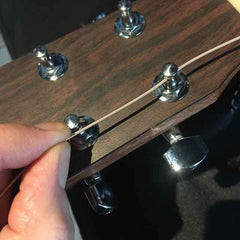 Measuring excess string length past the tuning peg for winding
Measuring excess string length past the tuning peg for winding
Step 8: Winding the String onto the Tuning Peg
Pull the excess string length back through the tuning peg. Begin winding the tuning peg counter-clockwise for the bass strings (E, A, D) and clockwise for the treble strings (G, B, e). Maintain tension on the string as you wind, ensuring the measured length remains consistent. The string coming from the nut should be on the inside of the tuning post.
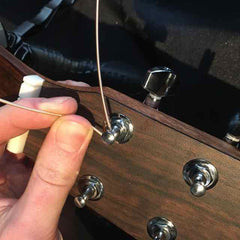 Winding a guitar string onto the tuning peg in the correct direction, maintaining tension
Winding a guitar string onto the tuning peg in the correct direction, maintaining tension
Step 9: Ensuring Proper String Winding Technique
As you wind, make sure the new string wraps are below the previous wrap, effectively pushing the previous wrap downwards towards the headstock. This technique creates a neat and secure string winding, further enhancing tuning stability.
 Close-up of proper string winding technique on a tuning peg, showing wraps below previous ones
Close-up of proper string winding technique on a tuning peg, showing wraps below previous ones
Step 10: Initial String Tension
Wind the tuning peg until there is a slight amount of tension on the string. Just a couple of winds around the post should be sufficient at this stage. You are not tuning to pitch yet, just getting some initial tension.
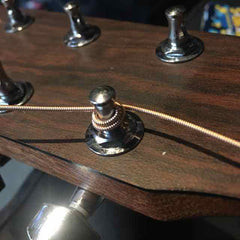 Applying initial tension to a newly installed guitar string with a few tuning peg winds
Applying initial tension to a newly installed guitar string with a few tuning peg winds
Step 11: Trimming Excess String
Using wire cutters, trim off the excess string extending beyond the tuning peg. Cut as close to the tuning peg as safely possible to keep the headstock area tidy and prevent string ends from poking you.
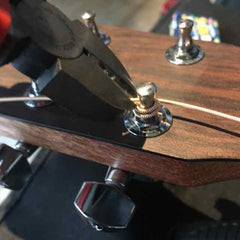 Trimming excess guitar string with wire cutters near the tuning peg
Trimming excess guitar string with wire cutters near the tuning peg
Step 12: Restringing Remaining Strings
Repeat steps 6 through 11 for the remaining five strings, working systematically from the thickest to the thinnest string. This process ensures all strings are correctly installed.
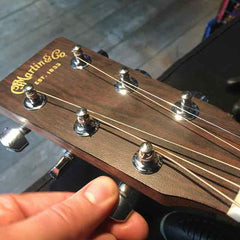 All six guitar strings restrung and trimmed at the headstock
All six guitar strings restrung and trimmed at the headstock
Step 13: Tuning to Pitch
Once all strings are installed, it’s time to tune your guitar to the correct pitch. Gradually bring each string up to pitch, moving back and forth between strings. This gradual tuning helps distribute tension evenly across the guitar neck, preventing sudden stress. Using a clip-on tuner can make this process much easier and more accurate.
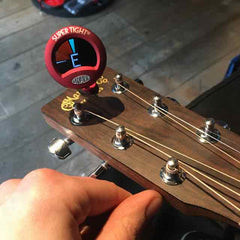 Using a clip-on guitar tuner to tune newly installed strings to pitch
Using a clip-on guitar tuner to tune newly installed strings to pitch
Step 14: Stretching the Strings
New strings need to be stretched to stabilize their tuning. Gently stretch each string by pulling it away from the fretboard along its length. Retune after stretching, as stretching will cause the strings to go flat. Repeat this stretch-and-tune process a few times for each string until they hold their pitch consistently. This step is crucial for minimizing tuning issues and ensuring your guitar stays in tune longer.
 Stretching new guitar strings to improve tuning stability
Stretching new guitar strings to improve tuning stability
Final Thoughts
Restringing your guitar is a fundamental skill that every guitarist should master. By following these steps, you can ensure your guitar sounds its best and is always ready to play. Regular string changes, combined with proper cleaning and maintenance, will not only improve your playing experience but also extend the life of your instrument. Now that you know how to restring your guitar, you’re all set to keep those strings fresh and your music sounding great!

